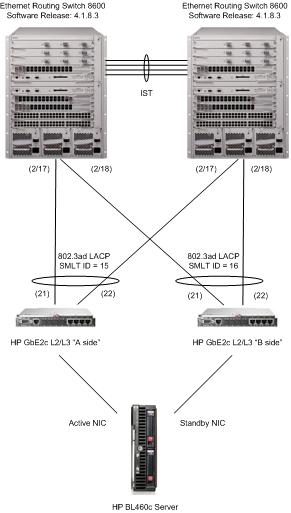In part 3 of this series I’ll provide a relatively simple example of a LACP LAG between a HP GbE2c L2/L3 switch and two Nortel switches, we’ll terminate two different LAGs on the two ERS 8600 switches using Nortel’s proprietary SMLT (Split MultiLink Trunking) technology.
Example 2 – Ethernet Routing Switch 8600 to a set of HP GbE2c L2/L3 switches using LACP trunks with SMLT
As I said before a picture is worth a thousand words and can be very helpful in designing any network topology.
I’m going to skip the configuration of the two Nortel Ethernet Routing Switch 8600s since you can refer to the earlier post for an example of how to configure them. In this design we need to disable the virtual cross connect that exists between the A and B sides of the two HP GbE2c switches. Please note that I’m working with the HP GbE2c (C-Class enclosure) not the GbE2 (P-Class enclosure). There are some slight differences between the two. The virtual trunk ports between the A and B sides are on ports 17 and 18 so those ports need to be disabled in order to prevent a loop.
HP-GbE2c-A / HP-GbE2c-B /c/port 17/dis /c/port 18/dis
With the virtual trunk cross connects disabled we can now wire each switch independently to the upstream switch(s) which in this case happens to be two ERS 8600s. As is usual for me I’ll create a network management VLAN and place the IP interface of each GbE2c switch in that VLAN (VLAN 200).
HP-GbE2c-A / HP-GbE2c-B /c/l2/vlan 200 /c/l2/vlan 200/ena /c/l2/vlan 200/name "10-101-255-0/24"
Let’s add VLAN 200 to the two ports, 21 and 22, that we’ll be using to uplink to the 8600 switches. We haven’t yet enabled tagging so the switch will ask you if you’d like to change the PVID from VLAN 1 (default) to VLAN 200, you can safely answer yes to this question.
HP-GbE2c-A / HP-GbE2c-B /c/l2/vlan 200/add 21 /c/l2/vlan 200/add 22
Let’s enable tagging on both uplink ports along with RMON and set the PVID just to be safe;
HP-GbE2c-A / HP-GbE2c-B /c/port 21/tag ena /c/port 21/pvid 200 /c/port 21/rmon e /c/port 22/tag ena /c/port 22/pvid 200 /c/port 22/rmon e
Let’s turn off Spanning Tree on the uplinks, we only want Spanning Tree local to the switch since SMLT will take care of providing the loop free topology.
HP-GbE2c-A / HP-GbE2c-B /c/l2/stp 1/port 21/off /c/l2/stp 1/port 22/off
Now it’s time to configure LACP and create the LAG (Link Aggregation Group). We’ll using LACP key 50 but you could use any admin key (number) so long as both ports are configured with the same admin key.
HP-GbE2c-A / HP-GbE2c-B /c/l2/lacp/port 21/mode active /c/l2/lacp/port 21/adminkey 50 /c/l2/lacp/port 22/mode active /c/l2/lacp/port 22/adminkey 50
Here’s the special sauce that will work in combination with the NIC teaming software to fail over in the event of an upstream switch problem or an uplink problem where the GbE2c continues to function but there’s a problem upstream. This configuration will cause the GbE2c switch to disable (admin-down) the server switch ports in the event that the LACP group goes down. This will cause the NIC teaming configuration on the servers to fail-over to the standby NIC.
HP-GbE2c-A / HP-GbE2c-B /c/ufd/on /c/ufd/fdp/ltm/addkey 50 /c/ufd/fdp/ltd/addport 1 /c/ufd/fdp/ltd/addport 2 /c/ufd/fdp/ltd/addport 3 /c/ufd/fdp/ltd/addport 4 /c/ufd/fdp/ltd/addport 5 /c/ufd/fdp/ltd/addport 6 /c/ufd/fdp/ltd/addport 7 /c/ufd/fdp/ltd/addport 8 /c/ufd/fdp/ltd/addport 9 /c/ufd/fdp/ltd/addport 10 /c/ufd/fdp/ltd/addport 11 /c/ufd/fdp/ltd/addport 12 /c/ufd/fdp/ltd/addport 13 /c/ufd/fdp/ltd/addport 14 /c/ufd/fdp/ltd/addport 15 /c/ufd/fdp/ltd/addport 16
If you haven’t already let’s configure an IP address (for management) on VLAN 200;
HP-GbE2c-A /c/l3/if 1/ena /c/l3/if 1/addr 10.1.255.128 /c/l3/if 1/mask 255.255.255.0 /c/l3/if 1/broad 10.1.255.255 /c/l3/if 1/vlan 200
We need to use a different IP address for the B side switch on VLAN 200;
HP-GbE2c-B /c/l3/if 1/ena /c/l3/if 1/addr 10.1.255.129 /c/l3/if 1/mask 255.255.255.0 /c/l3/if 1/broad 10.1.255.255 /c/l3/if 1/vlan 200
As mentioned by a few other folks on this blog and in the forums this solution only provides an active/passive solution in terms of the NIC teaming configuration. This is because the GbE2c L2/L3 switches don’t support IST/SMLT technology. While this will only provide 1Gbps of bandwidth (2Gbps if you count full duplex) between the blade server and the network it will provide significant level of redundancy and high-availability. In this design the network is protected from a GbE2c switch failure, a Nortel Ethernet Routing Switch 8600 failure, and multiple uplink/downlink failures.
Please feel free to post comments and questions here about this post. Questions regarding specific configurations can be posted in the forums; http://forums.networkinfrastructure.info/nortel-ethernet-switching/
Cheers!
